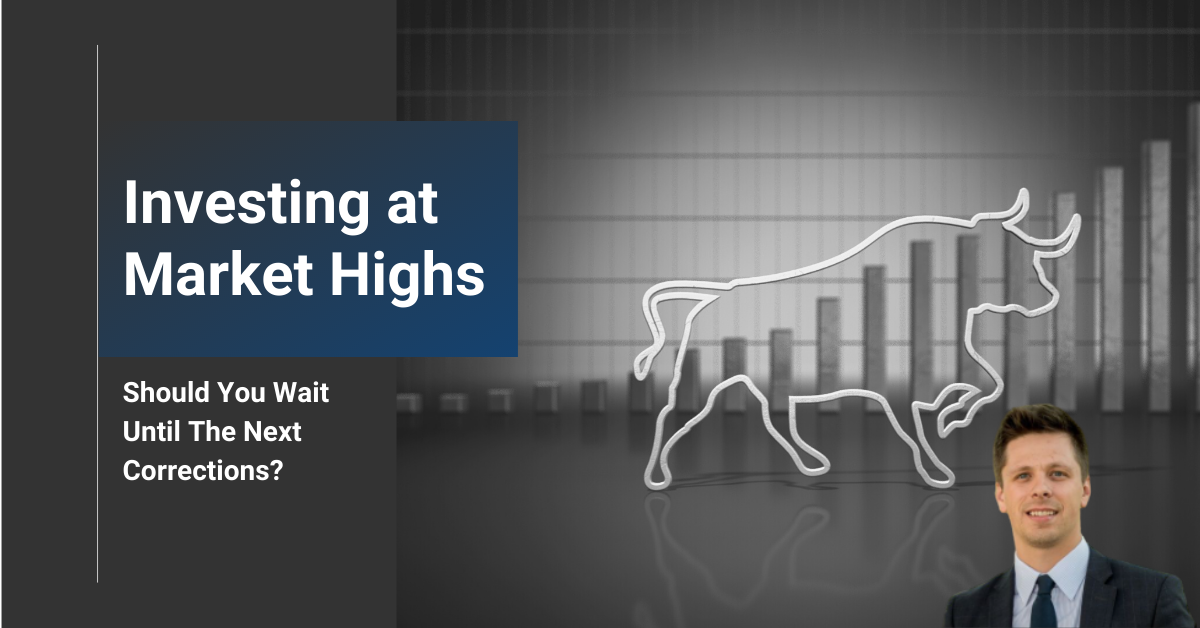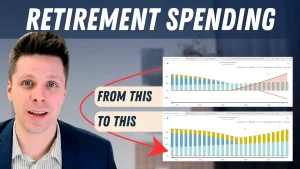[vc_row css=”.vc_custom_1612380408194{padding-top: 20px !important;padding-bottom: 20px !important;}”][vc_column][vc_column_text css=”.vc_custom_1619537666872{padding-top: 20px !important;padding-bottom: 20px !important;}”]Last week, I spoke about buying into the stock market when prices were low. As we saw, there have been many occasions where it would have been opportune to buy low over the last 25 years.[/vc_column_text][dt_fancy_image image_id=”5617″ width=”1000″][vc_column_text css=”.vc_custom_1619538525428{padding-top: 20px !important;padding-bottom: 20px !important;}”]
How about investing when markets are at all-time highs?
As we can see from the graph above, the US stock market is currently at an all-time high. If you have funds available to invest, should you buy today or wait for the next market correction to buy in while prices are low?
There’s one thing that has historically proven to be true about the stock market
- The long term trend of the market has always been upward
As much as the talking heads on Tv will have us believe, nobody knows whether the market will go up or down tomorrow, but we can all assume it will rise over time.
Armed with those assumptions, I would argue that today is as good a day as ever to invest.
Why risk it? Why not wait until we see some form of correction?
My argument to this would be, what if we don’t see a correction? In 2014-2015, markets were at all-time highs, having recovered from the 2008 financial crisis.[/vc_column_text][dt_fancy_image image_id=”5637″ width=”1000″][vc_column_text css=”.vc_custom_1619538498455{padding-top: 20px !important;padding-bottom: 20px !important;}”]Here is what some of the most popular talking heads on Tv were saying around that time.
David Rosenberg (June 4, 2011): “Another recession is coming, and soon. So says Gluskin Sheff economist David Rosenberg. Rosenberg, a longtime bear on the economy and the stock market, now says he is 99% sure we will have another recession by the end of next year.” – Fortune
Peter Schiff (May 30, 2013): “We’ve got a much bigger collapse coming…I am 100% confident the crisis that we’re going to have will be much worse than the one we had in 2008” – Marketwatch, and “The crisis is imminent. I don’t think Obama is going to finish his second term without the bottom dropping out. And stock market investors are oblivious to the problems.” – Money Morning
Carl Icahn (Sept 29, 2015): “I see real tremendous problems ahead and I don’t think we are handling it right and nobody really wants to talk [it] out… We are headed toward a strong correction and possibly a complete meltdown but not systemic like 2008. It won’t threaten the system, it’s just going to threaten your livelihood and net worth….I do think you are in a very massive bubble and when it bursts it isn’t going to be pretty, it could be a blood bath.” – Forbes[1]
As we can see from the graph, these doomsday prophecies never materialized, and the stock market kept going up. Even though markets were at all-time highs at that point, it still would have been a great time to invest as the stock market has never gone back to those prices.
Even if you buy at the worst possible time, you’ll still come out ahead
The most important part of investing is to give yourself time.[/vc_column_text][dt_fancy_image image_id=”5638″ width=”1000″][vc_column_text css=”.vc_custom_1619538466580{padding-top: 20px !important;padding-bottom: 20px !important;}”]Had you bought at the peak of the market in 2000 (Yellow Circle) today, your investment would have an annualized return of 7.3%. That’s still a pretty good rate of return, considering you would have bought at the worst possible time.
It doesn’t have to be all or nothing
Let’s say you have $500,000 that you currently have sitting in a saving account or a GIC. You’d like to get that money invested, but you’re concerned that the stock market is about to go through a correction.
Rather than investing it all at once, you can take advantage of dollar-cost averaging. This strategy allows you to buy over a period of time.
For example, you could split up your $500,000 to be invested monthly over five years. Every month you would add $8,333 to your investment account.
If the stock market continues to rise, you are at least investing some money today at lower prices. If the stock market goes through a correction in the short term, you didn’t invest your entire $500,000 at market highs.
Happy Investing!
Questions about your Portfolio? Get in touch with Marc below.
[1] https://am.jpmorgan.com/content/dam/jpm-am-aem/global/en/insights/market-insights/the-armageddonists-amv.pdf[/vc_column_text][/vc_column][/vc_row]






